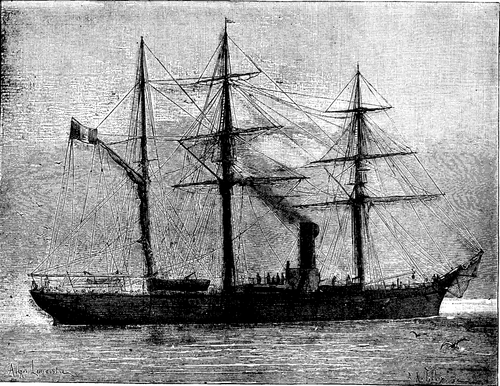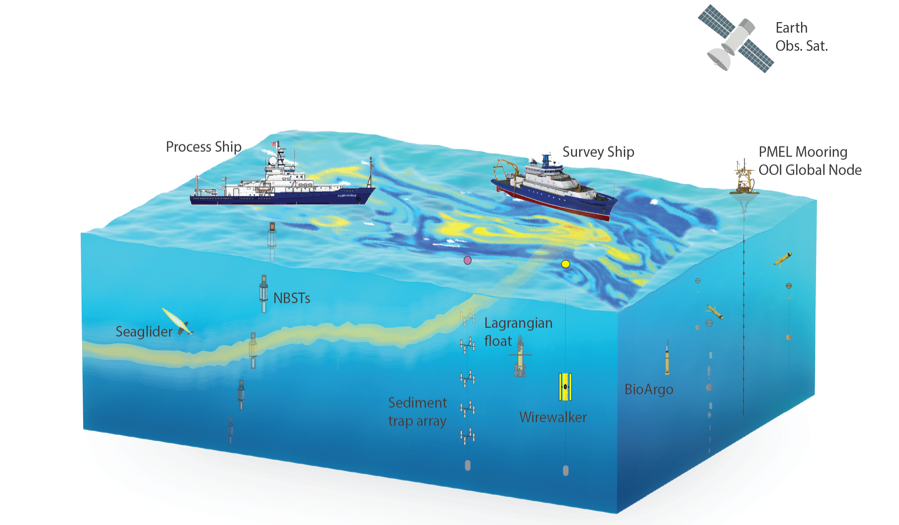|
French Aviso Talisman
''Le Talisman'' was a French Navy Sloop-of-war, sloop built at Le Havre in 1862 which was used for geological, biological and hydrological exploration in the Atlantic Ocean and Mediterranean Sea at the end of the 19th century. It first served as a communications vessel ("aviso"), and was both sail and propeller driven. In 1883 it was fitted out for scientific work under the direction of Professor Alphonse Milne-Edwards, equipped with a dredging winch with a capacity of 20 tons, and fitted to carry seven scientists together with a laboratory. From June to August 1883, the Talisman carried out a research cruise in the Bay of Biscay, on the coasts of Morocco, Senegal, the Canary Islands, Cape Verde and Azores, the Azores and in the Sargasso Sea, collecting considerable material via dredging, at depths of up to . Among the expedition scientists were: * Alphonse Milne-Edwards * Henri Filhol * Léopold de Folin, Leopold de Folin * Leon Valiant * Louis-Alexandre Vincent This cruise ... [...More Info...] [...Related Items...] OR: [Wikipedia] [Google] [Baidu] |
Sargasso Sea
The Sargasso Sea () is a region of the Atlantic Ocean bounded by four currents forming an ocean gyre. Unlike all other regions called seas, it has no land boundaries. It is distinguished from other parts of the Atlantic Ocean by its characteristic brown ''Sargassum'' seaweed and often calm blue water. The sea is bounded on the west by the Gulf Stream, on the north by the North Atlantic Current, on the east by the Canary Current, and on the south by the North Atlantic Equatorial Current, the four together forming a clockwise-circulating system of ocean currents termed the North Atlantic Gyre. It lies between 20° and 35° north and 40° and 70° west and is approximately wide by long. Bermuda is near the western fringes of the sea. While all of the above currents deposit marine plants and refuse into the sea, ocean water in the Sargasso Sea is distinctive for its deep blue color and exceptional clarity, with underwater visibility of up to 61 m (200 ft). It is a ... [...More Info...] [...Related Items...] OR: [Wikipedia] [Google] [Baidu] |
Research Vessels
A research vessel (RV or R/V) is a ship or boat designed, modified, or equipped to carry out research at sea. Research vessels carry out a number of roles. Some of these roles can be combined into a single vessel but others require a dedicated vessel. Due to the demanding nature of the work, research vessels may be constructed around an icebreaker hull, allowing them to operate in polar waters. History The research ship had origins in the early voyages of exploration. By the time of James Cook's ''Endeavour'', the essentials of what today we would call a research ship are clearly apparent. In 1766, the Royal Society hired Cook to travel to the Pacific Ocean to observe and record the transit of Venus across the Sun. The ''Endeavour'' was a sturdy vessel, well designed and equipped for the ordeals she would face, and fitted out with facilities for her "research personnel", Joseph Banks. As is common with contemporary research vessels, ''Endeavour'' also carried out more than ... [...More Info...] [...Related Items...] OR: [Wikipedia] [Google] [Baidu] |
Ships Built In France
A ship is a large watercraft that travels the world's oceans and other sufficiently deep waterways, carrying cargo or passengers, or in support of specialized missions, such as defense, research, and fishing. Ships are generally distinguished from boats, based on size, shape, load capacity, and purpose. Ships have supported exploration, trade, warfare, migration, colonization, and science. After the 15th century, new crops that had come from and to the Americas via the European seafarers significantly contributed to world population growth. Ship transport is responsible for the largest portion of world commerce. The word ''ship'' has meant, depending on the era and the context, either just a large vessel or specifically a ship-rigged sailing ship with three or more masts, each of which is square-rigged. As of 2016, there were more than 49,000 merchant ships, totaling almost 1.8 billion dead weight tons. Of these 28% were oil tankers, 43% were bulk carriers, and 13% were co ... [...More Info...] [...Related Items...] OR: [Wikipedia] [Google] [Baidu] |
Ships Of France
A ship is a large watercraft that travels the world's oceans and other sufficiently deep waterways, carrying cargo or passengers, or in support of specialized missions, such as defense, research, and fishing. Ships are generally distinguished from boats, based on size, shape, load capacity, and purpose. Ships have supported exploration, trade, warfare, migration, colonization, and science. After the 15th century, new crops that had come from and to the Americas via the European seafarers significantly contributed to world population growth. Ship transport is responsible for the largest portion of world commerce. The word ''ship'' has meant, depending on the era and the context, either just a large vessel or specifically a ship-rigged sailing ship with three or more masts, each of which is square-rigged. As of 2016, there were more than 49,000 merchant ships, totaling almost 1.8 billion dead weight tons. Of these 28% were oil tankers, 43% were bulk carriers, and 13% were cont ... [...More Info...] [...Related Items...] OR: [Wikipedia] [Google] [Baidu] |
1862 Ships
Year 186 (Roman numerals, CLXXXVI) was a common year starting on Saturday (link will display the full calendar) of the Julian calendar. At the time, it was known as the Year of the Consulship of Aurelius and Glabrio (or, less frequently, year 939 ''Ab urbe condita''). The denomination 186 for this year has been used since the early medieval period, when the Anno Domini calendar era became the prevalent method in Europe for naming years. Events By place Roman Empire * Peasants in Gaul stage an anti-tax uprising under Maternus (rebel), Maternus. * Roman governor Pertinax escapes an assassination attempt, by British usurpers. New Zealand * The Hatepe eruption, Hatepe volcanic eruption extends Lake Taupō and makes skies red across the world. However, recent radiocarbon dating by R. Sparks has put the date at 233 AD ± 13 (95% confidence). Births * Ma Liang (Three Kingdoms), Ma Liang, Chinese official of the Shu Han state (d. 222) Deaths * April 21 – Apolloniu ... [...More Info...] [...Related Items...] OR: [Wikipedia] [Google] [Baidu] |
Brachiopod
Brachiopods (), phylum Brachiopoda, are a phylum of trochozoan animals that have hard "valves" (shells) on the upper and lower surfaces, unlike the left and right arrangement in bivalve molluscs. Brachiopod valves are hinged at the rear end, while the front can be opened for feeding or closed for protection. Two major categories are traditionally recognized, articulate and inarticulate brachiopods. The word "articulate" is used to describe the tooth-and-groove structures of the valve-hinge which is present in the articulate group, and absent from the inarticulate group. This is the leading diagnostic skeletal feature, by which the two main groups can be readily distinguished as fossils. Articulate brachiopods have toothed hinges and simple, vertically-oriented opening and closing muscles. Conversely, inarticulate brachiopods have weak, untoothed hinges and a more complex system of vertical and oblique (diagonal) muscles used to keep the two valves aligned. In many brachiopods, a ... [...More Info...] [...Related Items...] OR: [Wikipedia] [Google] [Baidu] |
Pelican Eel
The pelican eel (''Eurypharynx pelecanoides'') is a deep-sea eel. It is the only known member of the genus ''Eurypharynx'' and the family Eurypharyngidae. It belongs to the "saccopharyngiforms", members of which were historically placed in their own order, but are now considered true eels in the order Anguilliformes. The pelican eel has been described by many synonyms, yet nobody has been able to demonstrate that more than one species of pelican eel exists. It is also referred to as the gulper eel (which can also refer to members of the related genus ''Saccopharynx''), pelican gulper, and umbrella-mouth gulper. The specific epithet ''pelecanoides'' refers to the pelican, as the fish's large mouth is reminiscent to that of the pelican. Description The morphology of pelican eel specimens can be hard to describe because they are so fragile that they become damaged when they are recovered from the deep sea's immense pressure. However, certain observations about the physical character ... [...More Info...] [...Related Items...] OR: [Wikipedia] [Google] [Baidu] |
Léopold De Folin
Léopold de Folin (Alexandre Guillaume Léopold de, Marquis de Folin, 28 August 1817 – 5 July 1896) was an author, oceanographer, malacologist and early founder (1871) of the collections which were to become the ''Musée de la mer'' (sea museum) in Biarritz, France De Folin wrote on Caecidae for the reports published following the Challenger expedition of 1872-1876. With Henri Milne-Edwards's son Alphonse, de Folin carried out a survey of the Gulf of Gascony. He worked on board the ''Travailleur'' (a paddle-wheel aviso) in 1880, and on board the '' Talisman'' in 1883, for trips to the Canary Islands, the Cape Verde Islands and the Azores. De Folin also described the genus '' Oceanida'' of sea snails in the family ''Eulimidae''. Relatives Léopold de Folin was the brother-in-law of the French naturalist Pierre Marie Arthur Morelet Pierre Marie Arthur Morelet (26 August 1809 – 9 October 1892) was a French natural history, naturalist, born in Lays, Doubs. He was a ... [...More Info...] [...Related Items...] OR: [Wikipedia] [Google] [Baidu] |
Henri Filhol
Henri Filhol Henri Filhol (13 May 1843 – 28 April 1902) was a French medical doctor, malacologist and naturalist born in Toulouse. He was the son of Édouard Filhol (1814-1883), curator of the Muséum de Toulouse. After receiving his early education in Toulouse, he moved to Paris, where he obtained doctorates in medicine and science. In 1879 he was appointed professor of zoology at the Faculty of Toulouse. From 1894 to 1902 he occupied the chair of comparative animal anatomy at the ''Muséum national d'Histoire naturelle'' in Paris. In 1897 he became a member of the ''Académie des sciences''. In the field of paleontology, he performed important studies of fossilized mammals in the phosphorites in Quercy.Henri Filhol (1843-1902)- Gloubik Sciences. He served as the expedition doctor and naturalist on the French 1874 Transit of Venus Expedition to Campbell Island, with Filhol Peak on the island being named after him.Tee, Garry JScience on the Map: Places in New Zealand Named A ... [...More Info...] [...Related Items...] OR: [Wikipedia] [Google] [Baidu] |
Azores
) , motto =( en, "Rather die free than subjected in peace") , anthem= ( en, "Anthem of the Azores") , image_map=Locator_map_of_Azores_in_EU.svg , map_alt=Location of the Azores within the European Union , map_caption=Location of the Azores within the European Union , subdivision_type=Sovereign state , subdivision_name=Portugal , established_title=Settlement , established_date=1432 , established_title3=Autonomous status , established_date3=30 April 1976 , official_languages=Portuguese , demonym= ( en, Azorean) , capital_type= Capitals , capital = Ponta Delgada (executive) Angra do Heroísmo (judicial) Horta (legislative) , largest_city = Ponta Delgada , government_type=Autonomous Region , leader_title1=Representative of the Republic , leader_name1=Pedro Manuel dos Reis Alves Catarino , leader_title2= President of the Legislative Assembly , leader_name2= Luís Garcia , leader_title3= President of the Regional Government , leader_name3=José Manuel Bolieiro , le ... [...More Info...] [...Related Items...] OR: [Wikipedia] [Google] [Baidu] |




_(cropped).jpg)